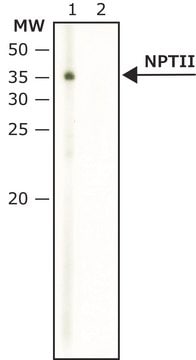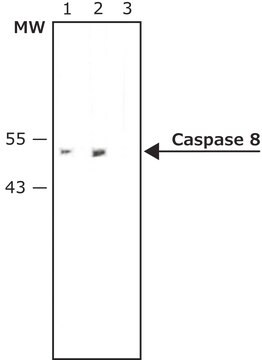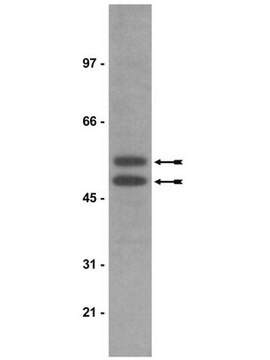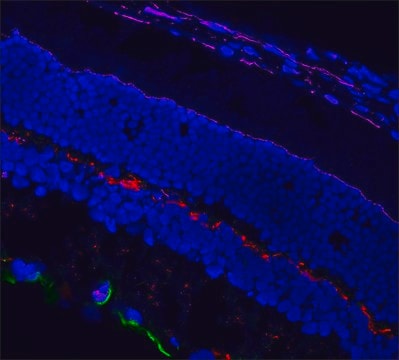06-747
Anti-Neomycin Phosphotransferase II Antibody
Upstate®, from rabbit
Synonym(s):
Anti-Neomycin II, Neomycin II Antibody, Neomycin Phosphotransferase Ab
About This Item
Recommended Products
biological source
rabbit
Quality Level
antibody form
purified immunoglobulin
antibody product type
primary antibodies
clone
polyclonal
species reactivity
human, bacteria
species reactivity (predicted by homology)
mouse, rat
manufacturer/tradename
Upstate®
technique(s)
western blot: suitable
isotype
IgG
UniProt accession no.
shipped in
wet ice
target post-translational modification
unmodified
General description
Specificity
Immunogen
Application
Epitope Tags & General Use
Epitope Tags
1-2 μg/mL dilutions of a previous lot detected NPT II in RIPA lysates from Cos-1 cells transfected with pUSE, harboring the neomycin resistance gene.
Quality
Western Blot Analysis:
1-2 μg/mL of a previous lot detected NPT II in RIPA lysate from Cos-1 cells transfected with pUSE, harboring the neomycin resistance gene.
Target description
Physical form
Storage and Stability
Handling Recommendations:
Upon receipt, and prior to removing the cap, centrifuge the vial and gently mix the solution. Aliquot into microcentrifuge tubes and store at 2 - 8°C. Avoid repeated freeze/thaw cycles, which may damage IgG and affect product performance. Note: Variability in freezer temperatures below 2 - 8°C may cause glycerol containing solutions to become frozen during storage.
Analysis Note
RIPA lysates from Cos-1 cells transfected with pUSE, harboring the neomycin resistance gene
Other Notes
Legal Information
Disclaimer
Not finding the right product?
Try our Product Selector Tool.
Storage Class Code
10 - Combustible liquids
WGK
WGK 1
Certificates of Analysis (COA)
Search for Certificates of Analysis (COA) by entering the products Lot/Batch Number. Lot and Batch Numbers can be found on a product’s label following the words ‘Lot’ or ‘Batch’.
Already Own This Product?
Find documentation for the products that you have recently purchased in the Document Library.
Our team of scientists has experience in all areas of research including Life Science, Material Science, Chemical Synthesis, Chromatography, Analytical and many others.
Contact Technical Service








